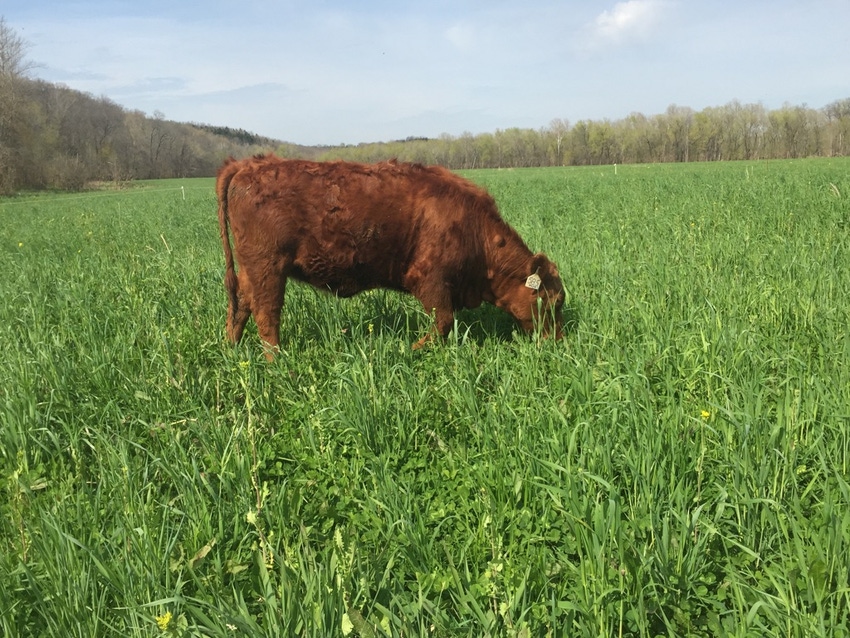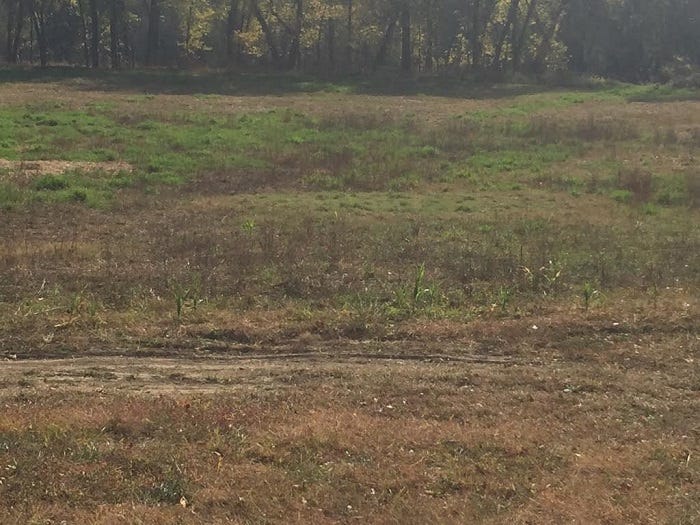November 13, 2017

By Ralph Voss
We have owned land along the Gasconade River for 44 years. There have been many challenging years during that period, but none were a bigger challenge than 2015.
Out of great challenges can come great learning experiences and we certainly had some learning opportunities last year. Before we talk about some of the things we learned, I’d like to explain how things were before the really challenging developments kicked in.
The year started off great. We have two river-bottom fields that suffered terribly from the all-time-record flood of 2013. But in the first half of last year those fields were starting to bounce back.
In what many in this area refer to as the Huot Bottom (because it was once owned by Ed Huot), an excellent stand of grass started to really come on. In both 2014 and 2015 we tried a combination of various grasses and legumes and had what we considered reasonably good success. We were able to try these many different varieties because the flood of 2013 had killed every blade of fescue and orchardgrass. When we planted what for us was new varieties in 2014 and 2015, they had no competition and as a result most of them did well, with some of what we sowed in 2014 carrying over into 2015. Among other things, we had Reed canary grass, peas, white, red and sweet clover, lespedeza, chicory, plantain, ryegrass, oats and cereal rye. Part of the canary grass was from recent plantings, while some had been there for 15 years or more.
In addition to the above, we had our usual crop of volunteers, including Virginia wild rye, river oats and some of our cows’ favorites, smooth and curly dock. Johnsongrass needs warm weather and it did not start growing until May or June. After the flooding there was also a large crop of barnyard grass, but this was not present during the cows’ first two trips through the bottom.
Floods first
We turned the cows into the Huot Bottom for the first time on April 20, 2015, and they relished the groceries. It was almost two months before they returned to that field – June 14 to be exact – and they didn’t get to stay there long.
On June 16 we had to get them out because the river was coming fast and the predicted crest was for enough water to cover everything. The government forecast was right on and this flood was the first of three to hit in four weeks. For the next two months the cows had to earn their living in the hills on fescue, a much tougher task than they had been accustomed to earlier in the season. They did well, however, and on Aug. 12 they got to make a return trip to the Huot Bottom. But this time it was not the picnic it had been in April.
The flooding in June and July had killed just about all the grasses and legumes we had planted earlier and by mid-August when we put the cows back into the bottom, they could eat barnyard grass, sedge, smartweed and cockleburs or they could go hungry. They chose to eat and that’s what I want to tell you about.
We had the third flood of four July 14. When we marched the cows to the Huot Bottom on Aug. 12, the water had only been off that field about three weeks. Every plant in the field was vegetative. Had that not been the case, I feel sure the cows would not have eaten the weeds they actually seemed to relish.
On Aug. 12 the old standby grasses of canary grass, Johnsongrass and ryegrass had not yet bounced back. While the canary grass later bounced back, the other two sustained considerable permanent damage.
There was a lot of young barnyard grass, which is very palatable, and the cows hit it hard. That came as no surprise. But I’ve never before seen one of our cows eat sedge, cockleburs or smartweed, but that summer they ate it with a lot more enthusiasm than they normally display for fescue.
Why would they eat weeds they usually would not touch? The first reason, as I mentioned, is that everything was vegetative. That made a big difference. Also, we grazed the herd tight or hard – however you want to think of it – by putting them in relatively small paddocks and moving them more often. Most of the time we move our cows daily, but that August it was obvious our grass was going to be in short supply as a result of the flooding and we decided we needed to force our cows to eat plants they normally would not have eaten. (See sidebar story.)
Not only did 2015 produce three floods in four weeks, on Dec. 29 we saw a flood crest of 34.19 feet, which narrowly missed topping the record of 34.39 feet established just two and one-half years earlier.
Then droughts
While we will long remember 2015 for all the flooding, we will not soon forget how dry it was, too.
Shortly after the flood waters subsided in July, the rain also quit. We went 100 days with little significant rain, and this also taught us a valuable lesson.
We have always known canary grass was drought-tolerant, but we gained new respect for the grass in 2015, as we learned of its persistence in the face of both flooding and drought. By late October – approaching 90 days of very dry weather – canary grass was by far the greenest grass in our bottom fields. It also tolerated the flooding better than the other grasses. It would be difficult to find anything more persistent.
The most valuable lesson we learned is that there is probably nothing better than switchgrass to tolerate flooding and provide forage in the middle of a drought. The biggest mistake I’ve made in our operation is I have failed to plant warm-season grasses years ago. Neighbor Kary Wolfe has a field of switchgrass about two miles upriver from us; this land is low and floods readily – similar to our lower fields – but the stand has persisted for years and remains green in the summer.
Many of us remember that warm-season grasses have a relatively short growing season extending from May until fall. Admittedly, that is a short growing season. But what we also need to remember is that over the course of a year, warm-season grasses will produce more forage than fescue – by a considerable margin. Also, warm-season grasses produce at a time when our fescue is most unpalatable and most toxic, and they are also more drought-tolerant. I’m in no way saying we should eliminate all of our fescue, because fescue cannot be beat in terms of fall and winter pasture.
Another thing that makes warm-season grasses more attractive is we’re learning that certain varieties of cool-season grasses can be planted with warm-season varieties and make pastures that can be grazed both earlier and later than warm-season grasses alone. Virginia wild rye and river oats are just two of the cool-season grasses that have been used successfully in this way.

After the floods in early 2015 and the drought later that summer, primarily the only green plants in the Huot Bottom on the Voss ranch were reed canarygrass.
Weed-eating tricks worked
I tried a trick a lady named Kathy Voth came up with to improve weed eating by our cows.
She recommends pulling weeds – the kind livestock normally would not eat – and putting them in a trough and pouring molasses on the weeds. The livestock will eat the weeds for the molasses and some – especially young heifers it seems – appear to develop a taste for the weeds. I tried the Voth method and possibly that may have had something to do with the way the cattle ate the weeds. In any event, I’m hoping that in the future our cattle are more willing to eat more weeds, especially the three very unpalatable kind to which I earlier referred.
I have used the Voth method in prior years and knew that it seems to help. One exception is ironweed, which our cows have never been willing to eat. Fortunately, we did not have an ironweed problem in 2015 and the cows ate most of what we put in front of them.
I should explain that our cattle have eaten dock for years. Whatever dock there was in August was devoured. Because that would not have been particularly noteworthy, I didn’t pay much attention to how much dock was even available for the cows to eat. The most prolific weeds, by far, were the sedge, smartweed and cockleburs, with these weeds being almost a solid stand in places. But the cows ate everything.
You might be wondering what kind of shape the cows were in after a diet like this. Actually they stayed in good condition during the summer and fall and remained in good condition into winter. We weighed everybody in January and most cows weighed 100 pounds more than prior years.
One other very important observation: When we put the cows into the bottom on Aug. 12, they all but ate the weeds to the ground. A couple weeks later when we moved them out of the bottom, they were only eating half of a cocklebur plant that two weeks earlier they would have eaten in its entirety. I assume that was because the plants had become more mature and were not as palatable.
That brings to mind one question: In a season when weeds proliferate, should we consider brush-hogging the weeds early so they remain vegetative and our cattle will eat them during the summer months when fescue becomes so unpalatable?
It would be easy to jump to the conclusion that a diet heavy in weeds made it possible for the cows to come through the winter in great shape. That may be accurate, but a very mild winter was probably just as important. In any event they performed well on the weeds.
Voss and his wife have a cow-calf operation and run a newspaper at Linn, Mo.
You May Also Like




